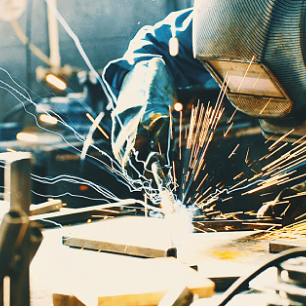Jump to:
Four New Automation-Related Products Aim to Streamline Tasks, Reduce Production Time
From cobots to a computer numerically controlled (CNC) controller, the emphasis is on efficiency, compatibility, usability, safety, and accuracy. There’s even a product line for industrial metrology applications.
Cobots Offer Larger Payload Capacity
Offered by ABB (abb.com), the GoFaTM 10 and 12 collaborative robots (cobots) handle payloads of up to 10 and 12 kg (22 and 26.4 lb), respectively. They automate machine tending, welding, parts handling, polishing, and assembly to achieve an extended range of demanding tasks. The GoFa 10’s 1.62-m (5.31 ft) reach also makes it useful for palletizing applications. In addition to their enhanced payloads, the cobots deliver tool center point speeds of up to 2 m/s (6.56 ft/s) with 0.02-mm (0.0008-in.) repeatability. IP67-certified against moisture and dust ingress, the cobots incorporate a range of features that allow them to be used safely alongside human workers without the need to design and build barriers or fencing. Their energy-saving features, including power regeneration and brake energy recovery, reduce power requirements by up to 20% for enhanced sustainability. Equipped with lead-through programming and the Wizard Easy Programming software, the cobots are easy to set up.
Robotic Welding Machine Facilitates 24/7 Operations
The Kemppi (kemppi.com) AX MIG Welder enables high-intensity, around-the-clock automated gas metal arc welding (GMAW). It is engineered to perform difficult tasks and meet demanding production targets. Compatible with most robotic welding systems, the machine’s fine-tuned ignition and precise seam tracking signal ensure repeatable, high-quality welds. For challenging materials, MAX or Wise arc performance welding processes can be used to increase speed, lower heat input, and ensure penetration. The machine also features the Weld Assist guidance tool for fast parameter setting, which allows welding to start up to 60% faster than when the manual parameter setting is used. Others features include collision detection to prevent the torch from hitting unwanted objects and touch sense ignition to minimize spatter and stabilize the arc immediately after ignition. With an intuitive user interface and easy-to-use controls, the unit can be operated with basic welding knowledge. Machine controls and real-time performance data can be accessed with a browser on any laptop or mobile phone. Its user interface can also be integrated into an existing control system.
CNC Controller Designed for Plasma and Oxyfuel Cutting
Produced by ESAB (esab.com), the Vision T6TM CNC controller for automated plasma and oxyfuel cutting machines features a multitouch, high-definition panel with a Windows operating system. The intuitive device includes such functions as swipe-to-zoom, drag-and-drop, and a familiar home button, which gives users quick and easy access to a range of features and capabilities so they can select and edit programs, create nests, locate parts on a plate, and cut. The unit has a 21.5-in. HD display that is 16% larger than its predecessor’s and connects with the Columbus® CAD/CAM programming and nesting software. Because of its plate and part awareness function, operators do not need to physically align the plate and can instead jog the machine to the plate corners or pick points along a plate remnant, even if it’s an irregular shape. The controller also has a built-in radio frequency identification (RFID) tag reader that allows fast and easy log-in/log-out for control of permissions and traceability. Its built-in process database with graphical selector makes plasma or oxyfuel process setup quick and easy.
Product Line Focuses on Industrial Metrology Applications
Renishaw (Renishaw.com) has introduced the RCS product line — comprised of the L-90, T-90, and P-series — for industrial metrology applications. It aims to transform the process of commissioning and servicing industrial automation technologies. The L-90 is a ballbar device that improves robot system accuracy, reduces deployment time, and monitors robot health with simple routines controlled by its supporting software suite. The T-90 is a tri-ballbar system that enables robot users to identify root causes of poor performance. Additional comprehensive tests can be performed to capture critical information, such as remastering the joint offsets to calculated positions, running master-recovery routines, and plotting 3D path performance. The P-series integrates a permanent probing solution within a robot cell to apply in-process metrology and automatic recovery to automation processes. All three products are supported by a dedicated software suite and focus on the problems associated with manual setup, calibration, and maintenance of robots, such as operational accuracy and repeatability.


